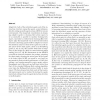Free Online Productivity Tools
i2Speak
i2Symbol
i2OCR
iTex2Img
iWeb2Print
iWeb2Shot
i2Type
iPdf2Split
iPdf2Merge
i2Bopomofo
i2Arabic
i2Style
i2Image
i2PDF
iLatex2Rtf
Sci2ools
AGENTS
2000
Springer
2000
Springer
Adaptivity in agent-based routing for data networks
Adaptivity, both of the individual agents and of the interaction structure among the agents, seems indispensable for scaling up multi-agent systems
MAS's
in noisy environments. One important consideration in designing adaptive agents is choosing their action spaces to be as amenable as possible to machine learning techniques, especially to reinforcement learning
RL
techniques 22 . One important way to have the interaction structure connecting agents itself be adaptive is to have the intentions and or actions of the agents be in the input spaces of the other agents, much as in Stackelberg games 2, 16, 15, 18 . We consider both kinds of adaptivity in the design of a MAS to control network packet routing 21, 6, 17, 12 We demonstrate on the OPNET event-driven network simulator the perhaps surprising fact that simply changing the action space of the agents to be better suited to RL can result in very large improvements in their potential performance: at their best settings, our le...
Adaptive Agents | AGENTS 2000 | Interaction Structure | Security Privacy | Structure Connecting Agents |
Related Content
| Added | 01 Aug 2010 |
| Updated | 01 Aug 2010 |
| Type | Conference |
| Year | 2000 |
| Where | AGENTS |
| Authors | David Wolpert, Sergey Kirshner, Christopher J. Merz, Kagan Tumer |
Comments (0)

